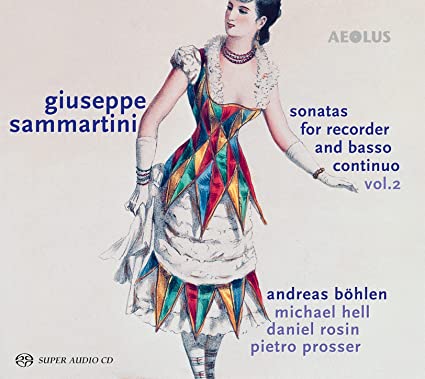

Sonata C major (Sibley No.8)
Sonata a Flauto Solo con il Basso F major (Sibley No.18)
Sonata a Flauto Solo con il Basso F minor (Sibley No.16)
Sonata a Flauto Solo con il Basso C major (Sibley No.26)
Sonata a Flauto Solo con il Basso D minor (Sibley No.20)
Sonata a Flauto Solo con il Basso D major (Sibley No.17)
Sonata a Flauto Solo con il Basso G minor (Sibley No.14)
About two years ago I posted a review of the Aeolus recording of Volume 1 of the Sonatas for Recorder and basso continuo by Giuseppe Sammartini (1695-1750). At the time I remarked that this composer's music is of the highest standards, full of invention and harmonic innovation, and even some peculiar twists and tricks. I had also pointed out that Andreas Böhlen's highly expressive, animated, and technically polished playing served this music very well. It's always difficult to improve on excellence but two years on and he, with the support from Michael Hell (harpsichord), Daniel Rosin (baroque cello) and Pietro Prosser (lute), come together again to deliver exceptional musicianship and bring to life these prime examples of Baroque sonatas for the recorder, from a composer unfairly overshadowed by his own younger brother, Giovanni Sammartini.
Andreas Böhlen's recording of Giuseppe Sammartini's rarely played recorder sonatas could be seen as "breaking new ground", deciphered and performed from manuscript sources, since there is no complete modern edition of these scores. The booklet notes even state: "Amazingly, considering the number of keen recorder players today, the thirty-two works have not yet been completely published in modern editions. Therefore, they are still not widely known in the recorder world." In my opinion, I would even say that they upstage the same type of work by say Telemann and/or Vivaldi, simply for their variety, and innovative harmonic and technical means. Some passages may have been easy to play on the baroque violin at the time, but with the recorder being the instrument of choice back then, it seems that Giuseppe Sammartini imposed as many technical demands as possible on the recorder player. Had Andreas Böhlen been a recorder player back in the 1700s, he would certainly have been considered a master of the instrument, as he makes child's play of any and all technical hurdles along the way.
If you enjoy Baroque music in general, and especially music for the recorder, I wouldn't hesitate even for a second in recommending these two impressive volumes bringing together the intensely rewarding music of Giuseppe Sammartini. Both CD cover images display characters dressed up as Saltimbanques entertainers of the day, a perfect indication of the music at hand.
Jean-Yves Duperron - January 2022